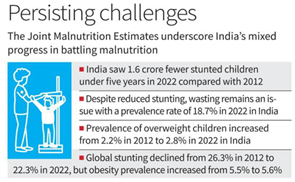

29th May 2023 (6 Topics)
Context
According to UNICEF, WHO, and World Bank Joint Malnutrition Estimates, there will be 1.6 crore fewer stunted children under the age of five in 2022 than there were in 2012, obesity incidence has slightly grown over the past ten years.
Key highlights of the report:
- The Joint Malnutrition Estimates (JME) released by UNICEF, WHO and the World Bank revealed that India recorded 1.6 crore fewer stunted children under five years in 2022 as compared to 2012.
- Stunting: This was accompanied by India's share of the global burden of stunting declining from 30% to 25% in the past decade.
- Wasting: The prevalence of wasting in 2022 was 18.7% in India, with a share of 49% in the global burden of this malnutrition indicator.
- Obesity: The prevalence of obesity marginally increased in a decade from 2.2% in 2012 to 2.8% in 2022 with the numbers growing to 31.8 lakh from 27.5 lakh.
|
- Sustainable Development Goal (SDG) Targeting: There is insufficient progress to reach the 2025 World Health Assembly (WHA) global nutrition targets and the 2030 Sustainable Development Goal (SDG) 2 targets; only about one-third of all NFHS-5 showed evidence of continued reduction of stunting and instances of underweight children, though anaemia was disappointing.
- Concerns: It also showed an improvement in access to health services such as family planning, ante-natal care, deworming, and breastfeeding counselling.
- Wasting is an outlier, with two-thirds of children at 12 or 24 months having wasting at birth or at one month of age.
- This means that children were born with very low weight for height and didn't recover even six months or 12 months later despite weight gain.
- Estimation: The JME estimates for stunting and obesity are based on country-level modelled estimates derived from primary sources, while for wasting, the estimates are based on national-level country prevalence data.
More Articles


